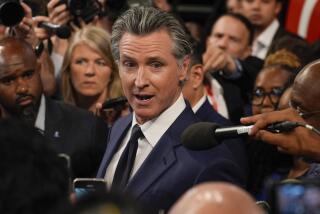Governor Signs Bill Granting a State Tax Rebate of $1.1-Billion
- Share via
SACRAMENTO — Gov. George Deukmejian signed legislation Monday giving Californians a $1.1-billion tax rebate, the first refund ever granted under a state spending limit approved overwhelmingly by voters in 1979.
Between Nov. 1 and Christmas, 13 million people who filed state income tax returns for 1986 will receive checks ranging from $32 to $118 for individuals and $64 to $236 for couples. The rebate plan was passed by the Legislature on the final day of this year’s session.
“I think that we can be very pleased that we were able to protect this money for the taxpayers and that we have honored the spending limit that was enacted by the voters through the initiative process,” Deukmejian said at a ceremony where he signed two bills implementing the refund.
Deukmejian’s approval of the bipartisan compromise during the final week of the legislative session ended a bitter struggle over what to do with $1.1 billion collected by the state in excess of California’s constitutional spending limit. This was the first year that state revenues exceeded the state spending limit, thus triggering the rebate.
Divert Money
Democratic lawmakers and state Schools Supt. Bill Honig had sought unsuccessfully to divert the money to the public schools, which they contend are badly in need of additional funds.
As part of the compromise, Deukmejian agreed to restore $87 million in aid to urban school districts that he had cut from this year’s budget, including $31 million earmarked for the Los Angeles Unified School District.
Under the rebate, taxpayers will receive a refund of about 15% of the amount they paid in state income taxes in 1986, up to a maximum of $118 for individuals and $236 for couples who filed a joint return.
Every individual who filed a state income tax return for last year will receive at least $32, regardless of whether that individual paid any state income taxes. This provision--a concession to Democrats--is designed to distribute a share of the money to lower-income Californians, such as renters who filed a tax return to receive their renter’s credit and senior citizens who are eligible for property tax assistance benefits.
Deukmejian called it the largest tax refund in the state’s history, which is true in strictly dollar totals. But in 1973, under Gov. Ronald Reagan, a $430-million tax cut reduced taxpayers’ liabilities by up to 35%. In all, there were three tax refunds under Reagan and one under his successor, Gov. Edmund G. Brown Jr.
Pledged Support
Although Democratic legislators agreed to this year’s tax rebate compromise, they also pledged to support efforts in 1988 to loosen the state’s spending limit, which is calculated according to a formula based on inflation and population growth. Democrats maintain that annual increases in the limit do not keep pace with economic growth and restrict the state’s ability to pay for schools, health and other needed services.
Some Democrats opposed the rebate because they feared that mailing rebate checks to taxpayers could undermine Democratic efforts to win voter approval of a ballot initiative loosening the spending limit. But other Democrats said privately that they did not see how they could persuade voters to raise the spending limit if the state was sitting on a $1.1-billion surplus.
No Democrats, including Sen. Henry Mello (D-Watsonville) and Assemblyman Gary Condit (D-Ceres), the authors of the two bills, were present at the bill signing ceremony in the governor’s office. Deukmejian told reporters that both lawmakers were out of the state.
But Assembly Republican Leader Pat Nolan of Glendale, who did attend the ceremony, praised Proposition 4, the 1979 initiative sponsored by anti-tax crusader Paul Gann, for limiting the “growth” of state government.
“Basically, we feel they (taxpayers) know better how to spend the money than the government does,” Nolan said.
More to Read
Get the L.A. Times Politics newsletter
Deeply reported insights into legislation, politics and policy from Sacramento, Washington and beyond. In your inbox three times per week.
You may occasionally receive promotional content from the Los Angeles Times.










